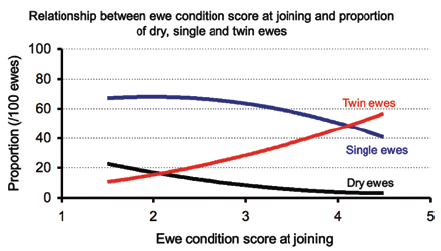Nutrition in ewes leading up to joining, late winter – spring lambing
01 Feb 2019
Sue Street, Senior Land Services Officer - Livestock
Ewe nutrition plays a pivotal role in meat and wool production systems. Body condition and live weight play a major role in a number of areas, especially if the ewes are in the right condition at the right time. Ewe nutrition is the most important factor to ensure the best reproductive performance in your flock. Therefore protein and energy play a huge role in the lead up to joining. A dry ewe requires around 7-8 MJME per kg/DM and approximately 7 – 8 % protein per head per day.
Nutrition of the ewe can be measured in many different ways, but one of the most effective methods is measuring body condition score (BCS). This is due to the fact that condition scoring is a quick and reliable tool for managing ewes to meet production targets, is independent of frame size and enables timely decisions to optimise reproduction rates. Lifetime Wool and Meat and Livestock Australia recommends that all ewes to be joined should be at approximately condition score 3.0 to 3.5 and that maiden ewes need to be at least 75-80% of their mature weight at joining.
For example a maiden ewe with a mature weight of 45kg needs to be joined at a weight of approximately 34-36kg and at BCS 3-3.5. Studies conducted by Lifetime Wool have shown that an increase of around 20% extra lambs have been reared for each rise in condition score at joining. This however does not include BCS of 4-5, as ewes that are deemed too fat will have problems at both conception and at lambing. Also joining ewes below BCS 1.5 is deemed to be unproductive as it is unlikely this animal will conceive.
 The requirements for protein and energy increases 2.5 – 3 fold during late pregnancy and early lactation, and ewes often cannot eat enough pasture to meet these needs. As a result of this, ewes will start to mobilise fat and muscle and this highlights the importance of having ewes in the optimum body condition score at joining.
The requirements for protein and energy increases 2.5 – 3 fold during late pregnancy and early lactation, and ewes often cannot eat enough pasture to meet these needs. As a result of this, ewes will start to mobilise fat and muscle and this highlights the importance of having ewes in the optimum body condition score at joining.
One of the best methods to ensure that a higher proportion of ewes conceive is to monitor condition score of the ewe from weaning. During this post weaning/pre joining period draft off the ewes in lower condition (below BCS 2) and allocate these animals the best feed. If you have green pasture this is a cost effective way to manage these ewes, unfortunately if you are supplement feeding these animals will require more feed, therefore they are more expensive to manage.
Due to the ongoing dry conditions, early weaning might be for you when it comes to getting your ewes back into lamb. Early weaning is an effective method as feeding a dry ewe and a weaned lamb requires less energy compared to feeding an ewe and lamb unit. However I do encourage you to do your research and understand the planning and risks involved in early weaning lambs.
For more information on nutrition in ewes leading up to joining, contact your Local Land Services Ag Advisory team member.